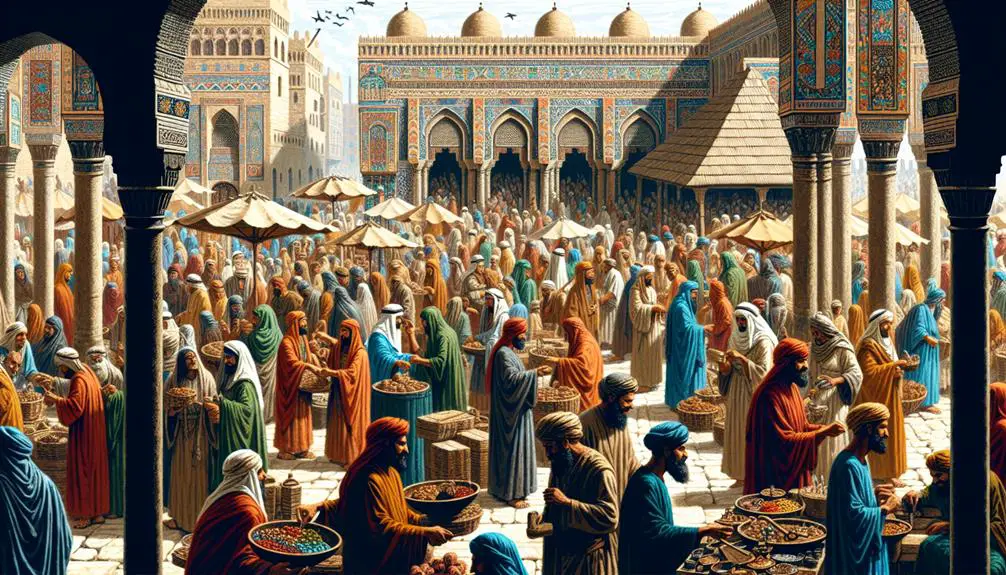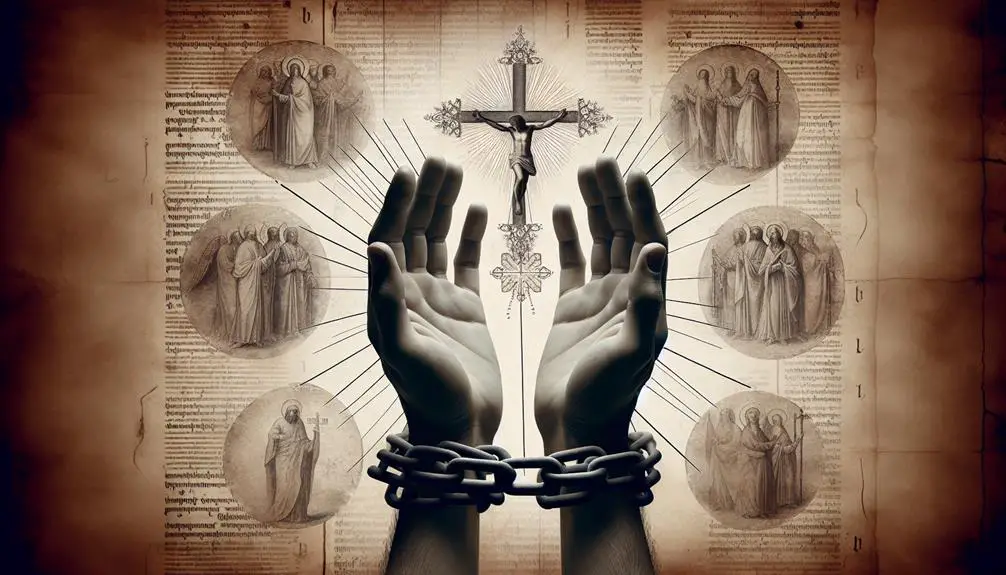Kneeling at the crossroads of history and theology, 'Slave in the Bible Meaning' unveils a complex narrative that demands a closer look.

Slave in the Bible Meaning
The concept of slavery within the biblical context presents a complex and multifaceted study, weaving through historical, cultural, and theological landscapes. From the Old Testament's accounts of Hebrew bondage in Egypt to the New Testament's metaphorical use of slavery to illustrate spiritual servitude, the term 'slave' carries significant weight and varying interpretations.
This exploration will not only shed light on the historical and scriptural nuances of slavery but also challenge us to consider its ethical ramifications and contemporary relevance. As we unpack these layers, one might find themselves confronted with questions that resonate far beyond ancient texts, inviting a deeper reflection on freedom, morality, and humanity itself.
Key Takeaways
- Biblical references to slavery often encompass both literal servitude and metaphorical spiritual bondage.
- Laws and narratives within the Bible reflect the complex socio-economic and ethical dimensions of slavery in ancient societies.
- Biblical texts use the imagery of slavery and liberation to convey deeper theological and moral teachings on humility, redemption, and divine justice.
- Modern interpretations of biblical slavery require cultural sensitivity and ethical reconsideration to align ancient texts with contemporary values.
Historical Context of Biblical Slavery

To understand the term 'slave' within the biblical context, it is essential to explore the multifaceted historical backdrop of slavery as it was practiced in ancient Near Eastern societies, including those depicted in the Bible. This exploration reveals that slavery in these societies was not a monolithic institution but varied significantly across different cultures and epochs. Cultural comparisons demonstrate that while some societies utilized slavery primarily for domestic service, others employed slaves in a variety of roles, including agriculture, industry, and even as bureaucrats and military personnel. This variation in the roles and statuses of slaves underscores the complexity of defining slavery solely through a biblical lens.
The economic impacts of slavery in these ancient societies cannot be overstated. Slavery was integral to the economies of many Near Eastern societies, providing labor for agriculture, construction, and other sectors. The economic foundation of slavery in these societies was intertwined with their social and political structures, influencing laws, family life, and even religion. Understanding this economic dimension is crucial for grasping the implications of slavery within the biblical context, as it sheds light on the social and economic hierarchies that influenced the lives of slaves and free persons alike.
Old Testament Perspectives

Turning to the Old Testament perspectives, it is crucial to examine the context of Hebrew slavery, the laws governing servitude, and the overarching themes of liberation.
These elements collectively provide insights into the social, legal, and theological dimensions of slavery as portrayed in ancient texts.
A thorough analysis of these points will illuminate the complexities and nuances of the concept of slavery within the Old Testament framework.
Hebrew Slavery Context
In the context of the Old Testament, the term 'slave' encompasses a complex socio-economic and legal status, significantly differing from modern perceptions of slavery. This status was intricately tied to the economic structures and social hierarchies of ancient Hebrew society.
- Economic structures: Slavery often emerged as a means to address personal debt or poverty, integrating individuals into households where they could work off their obligations.
- Social hierarchies: Being a slave reflected one's position within the broader social and economic framework, rather than merely denoting property.
- Legal status: The legal system provided certain protections to slaves, distinguishing their treatment from the chattel slavery known in other historical contexts.
Understanding this context is crucial for interpreting references to slavery within Old Testament narratives accurately.
Servitude Laws Overview
Several biblical laws provided a framework for servitude, reflecting the Old Testament's nuanced understanding of this social and economic institution. These laws, deeply embedded within the societal norms of ancient Israel, distinguished between different forms of servitude, including those instituted as a consequence of debt practices and the treatment of foreign captives.
Debt-induced servitude allowed individuals who could not repay their debts to serve their creditors, thereby providing a mechanism to avoid the severities of poverty and destitution. Conversely, the laws concerning foreign captives frequently resulted from military conquests, delineating a distinct category of servitude that, while regulated, was markedly different from the treatment of fellow Israelites.
This bifurcation underscores a complex legal and ethical landscape surrounding the practice of servitude in ancient Israelite society.
Liberation Themes Explored
While the laws surrounding servitude in ancient Israel provided a structured approach to debt and captivity, the Old Testament also encompasses significant liberation themes, particularly in its narratives and legal stipulations. These themes are not only central to understanding the socio-religious fabric of ancient Israel but also highlight the moral and ethical considerations of freedom and human dignity.
The Exodus narrative stands as a paramount example of freedom narratives, symbolizing the emancipation of the Israelites from Egyptian bondage.
Prophetic literature often advocates for social justice and the release of those unjustly enslaved, reinforcing emancipation representation.
The Year of Jubilee (Leviticus 25) mandates the release of all servants and the return of property, underscoring a cyclic renewal of freedom and economic rebalance.
These elements collectively contribute to a nuanced understanding of liberation as a divine mandate and a societal obligation within the Old Testament.
New Testament Interpretations

The concept of 'slave' within the New Testament is multifaceted, reflecting both the historical context of the era and the theological nuances introduced by early Christian teachings. In examining this concept, a critical look at Paul's letters reveals a significant evolution in the understanding and application of slavery within the early Christian community, especially among Gentile converts.
Paul's epistles, such as to the Galatians and Ephesians, demonstrate a complex view of slavery that intertwines socio-economic realities with a new spiritual paradigm. For instance, Paul addresses slaves and masters directly, urging them to treat each other with mutual respect and kindness, reflecting the Christian values of love and equality. This approach was revolutionary, considering the prevalent societal norms that dehumanized slaves.
Furthermore, Paul's teachings to the Gentile converts emphasized a spiritual liberation and equality before God, which subtly undermined the traditional Roman hierarchical structures of slavery. He famously declared in Galatians 3:28 that in Christ, there is neither Jew nor Gentile, neither slave nor free, nor is there male and female, for all are one in Jesus Christ. This theological assertion introduced a radical notion of spiritual equality that transcended social and economic statuses, challenging the established norms of the time.
Symbolic and Metaphorical Uses

Within the biblical text, the concept of 'slave' transcends its literal meaning, adopting symbolic and metaphorical dimensions that deepen its interpretative layers. The imagery of servitude is often utilized to elucidate spiritual conditions, ranging from bondage to sin to the pursuit of liberation through divine intervention.
This exploration into the symbolic uses of 'slave' reveals the nuanced ways in which biblical authors conveyed complex theological and moral concepts.
Servitude Imagery Explained
In biblical literature, servitude imagery often carries symbolic and metaphorical meanings that extend beyond literal enslavement, reflecting deeper spiritual and moral themes. This nuanced portrayal encompasses a range of cultural nuances and economic implications, offering a multifaceted understanding of servitude within the biblical context.
Key aspects include:
- Cultural Nuances: The depiction of servitude reflects the diverse cultural practices and norms of ancient societies, offering insight into their social structures and values.
- Economic Implications: Biblical narratives often use servitude to symbolize economic dependency and the complexities of wealth and poverty.
- Moral and Spiritual Lessons: These stories frequently convey moral teachings, using the condition of servitude as a backdrop for exploring themes of humility, liberation, and divine justice.
Spiritual Bondage Interpretation
Exploring the spiritual bondage theme in biblical texts reveals a profound metaphorical layer that underscores the struggle between sin and redemption. This concept serves as a powerful allegory for the human condition, where the enslavement to sin contrasts sharply with the quest for personal freedom and spiritual awakening.
Biblical narratives often employ the imagery of bondage to illustrate the soul's captivity to worldly desires and the divine pathway towards liberation. This interpretation invites readers to reflect on their own spiritual journey, recognizing the chains that bind them and the transformative power of faith in achieving true freedom.
Through this lens, spiritual bondage becomes not just a historical or cultural reference, but a timeless call to examine and overcome the internal barriers to personal and spiritual growth.
Metaphors of Liberation
The Bible employs a rich tapestry of metaphors of liberation, symbolically illustrating the journey from enslavement to spiritual emancipation. These metaphors serve as pivotal components in freedom narratives, providing a framework through which the concept of liberation is explored and understood. The use of emancipation symbolism within scriptural texts not only reflects the physical act of being freed from bondage but also delves into the spiritual and moral liberation that follows.
- Exodus as a paradigm of deliverance: The story of the Israelites' escape from Egypt stands as a powerful symbol of liberation from oppression.
- Chains to freedom: Imagery of breaking chains represents the overcoming of spiritual bondage.
- Promised Land as a metaphor: Symbolizing the ultimate attainment of freedom and a new beginning for those released from bondage.
Ethical Considerations

Addressing the ethical considerations surrounding the concept of 'slave' in the Bible necessitates a nuanced understanding of historical context and moral frameworks. The interpretation and application of biblical texts on slavery have evolved, reflecting broader shifts in moral perspectives and societal values. This evolution underscores the importance of considering cultural relativity and moral evolution when engaging with these texts today.
Aspect |
Relevance |
|---|---|
Historical Context |
Crucial for understanding the societal norms and practices at the time of the biblical texts' composition. |
Cultural Relativity |
Acknowledges that moral judgments are influenced by cultural contexts, affecting interpretations of slavery. |
Moral Evolution |
Highlights how ethical standards change over time, impacting contemporary views on biblical slavery. |
Interpretative Lenses |
Different theological and ethical lenses can lead to varied understandings of slavery in biblical texts. |
Societal Reflections |
The way societies reflect on biblical slavery can inform current discussions on morality and ethics. |
This analytical approach illuminates the complexity of discussing slavery in a biblical context without advocating for or against specific interpretations. It recognizes that what was once culturally acceptable can be seen through a different moral lens today, reflecting the dynamic nature of ethical standards. This perspective also allows for a critical examination of how historical texts are used to justify or condemn practices in contemporary society. Understanding these dimensions is vital for any informed discussion on the ethical implications of biblical references to slavery, ensuring a balanced and thoughtful analysis that respects both historical authenticity and modern moral sensibilities.
Modern Reflections and Applications

In contemporary discourse, discussions about the role and interpretation of 'slave' in the Bible often serve as a mirror, reflecting society's evolving values and ethical standards. As we navigate through historical texts, the term 'slave' within biblical contexts requires a nuanced understanding that aligns with modern values of cultural sensitivity and social justice. This evolution in interpretation underscores the importance of re-examining ancient texts through the lens of contemporary ethical considerations.
The modern reflections and applications of the concept of 'slave' in the Bible can be understood through several key perspectives:
- Cultural Sensitivity: Recognizing that historical contexts differed greatly from today's societal norms, there's a growing emphasis on interpreting biblical references to slavery with an understanding of the cultural and temporal backdrop against which these texts were written.
- Social Justice: The biblical narrative of liberation from slavery has been appropriated in modern times as a metaphor for the fight against oppression and injustice. This perspective encourages a reading of the Bible that aligns with contemporary movements for social justice, advocating for the rights and dignity of all individuals.
- Ethical Reinterpretation: Scholars and theologians are increasingly engaging in efforts to reinterpret passages related to slavery in a way that condemns any form of dehumanization or exploitation, reflecting a broader ethical stance that values the inherent worth of every person.
These reflections demonstrate a collective effort to reconcile ancient texts with modern values, aiming to foster a more inclusive and empathetic understanding of the Bible's teachings. This approach encourages a thoughtful engagement with historical religious texts, ensuring their relevance and resonant power in today's world.
Frequently Asked Questions
How Did the Concept of Slavery in the Bible Influence Early Christian Attitudes Towards Contemporary Social Justice Issues?
The examination of early Christian attitudes towards social justice issues reveals a complex interaction with the concept of slavery. These attitudes were shaped by prevailing social dynamics and ethical perspectives of the time.
An analytical and objective assessment suggests that interpretations of biblical texts on slavery influenced the ethical frameworks within which Christians engaged with contemporary social justice challenges, guiding their responses to issues of inequality and human dignity.
Are There Any Specific Rituals or Ceremonies Mentioned in the Bible That Were Used to Mark the Beginning or End of Someone's Period of Servitude?
In the tapestry of biblical narratives, there are indeed mentions of specific rituals marking the transition of servitude. The most notable is the ceremony of freeing a servant in the Jubilee year, as outlined in Leviticus 25.
Additionally, the ritual of piercing a servant's ear to signal a voluntary lifetime commitment is documented in Exodus 21. These servant rituals and freedom ceremonies underscore the socio-religious fabric of ancient societies, reflecting a structured approach to servitude.
How Have Different Translations of the Bible Affected the Understanding and Interpretation of Passages Related to Slavery?
Different translations of the Bible have significantly influenced the understanding and interpretation of passages related to slavery. Variations in translation accuracy can lead to divergent interpretations, emphasizing the importance of considering the cultural context in which these translations are undertaken.
An analytical and objective examination reveals that nuances in language and the historical context of the translators play a crucial role in shaping contemporary perceptions of biblical references to slavery.
What Role Did the Concept of Slavery in the Bible Play in the Justification or Condemnation of Slavery During the American Civil War?
During the American Civil War, the concept of slavery as depicted in Biblical texts played a significant role in both justifying and condemning the institution. Proponents and opponents of slavery selectively utilized scriptural interpretations to support their respective stances, often influenced by underlying economic motivations.
This divergence in Biblical understanding underscored the complex interplay between religious beliefs and economic interests, shaping the ideological battlefield of the era.
Can the Biblical Concept of Slavery Be Reconciled With Modern Christian Values Emphasizing Freedom and Equality for All?
Reconciling the biblical concept of slavery with contemporary Christian values requires a nuanced understanding. Through the lens of cultural relativism, ancient scriptural references to servitude can be seen as spiritual metaphors rather than endorsements of physical bondage.
An analytical and objective evaluation reveals that modern interpretations emphasizing freedom and equality align with the overarching themes of redemption and love, pivotal to Christian teachings.
Conclusion
In conclusion, the multifaceted concept of slavery within the biblical text is deeply embedded in its historical, cultural, and theological contexts.
Through a careful examination of Old and New Testament perspectives, alongside symbolic interpretations and ethical considerations, one discerns the evolution of the notion from a literal practice to metaphorical and ethical teachings.
Modern reflections underscore the importance of understanding these nuances, advocating for interpretations that foster inclusivity, compassion, and justice, resonating with contemporary values and moral sensibilities.



Sign up